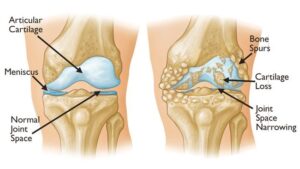What is Osteoarthritis of the knee?

Painful knees are a common problem in middle-aged and elderly people and the most common cause of knee pain in this group is knee arthritis.
Osteoarthritis is the most common type of arthritis, constituting almost 85-90% of all the different types of arthritis.
Osteoarthritis occurs when the cartilage that cushions the ends of bones in your joints gradually undergoes wear and tear. Cartilage is a firm, glistening tissue that allows the joints to move without any friction.
Eventually, if the cartilage wears down completely, the bone will rub on the bone, causing pain, stiffness, loss of flexibility, and swelling in the joint.
Is Surgery the only Solution to Arthritis?
There are quite a few treatments for early arthritis of knee like weight reduction, anti-inflammatory medications, nutritional supplements, visco-supplementation, steroid injections (rarely used nowadays), and physical therapy which can include localized treatments (Hot /Cold fomentation, Massages), and exercises.
 When these conservative modalities fail to give pain relief or improve movement and start interfering with quality of life and activities of daily living then either a Partial or a Total Knee Replacement could be considered as an option. The decision to have a knee replacement is a personal one, while most patients elect to have the surgery when they can no longer bear the pain, others will decide to have the surgery when they feel that their knee arthritis is preventing them from participating in activities that they enjoy.
When these conservative modalities fail to give pain relief or improve movement and start interfering with quality of life and activities of daily living then either a Partial or a Total Knee Replacement could be considered as an option. The decision to have a knee replacement is a personal one, while most patients elect to have the surgery when they can no longer bear the pain, others will decide to have the surgery when they feel that their knee arthritis is preventing them from participating in activities that they enjoy.
Before unduly delaying the procedure one should understand that osteoarthritis is a degenerative disease that worsens over time, often resulting in chronic pain. Depression and sleep disturbances often result from the pain and disability of osteoarthritis.
Also if the deformity is such that it starts affecting the other joints, like the same side hip or the opposite side knee or even the lower spine, then your doctor could advise the surgery for the patient.
What is Partial knee replacement?
The knee has three primary compartments:
- Medial compartment (inside)
- Lateral compartment (outside)
- Patellofemoral compartment (front)
Patients with only one damaged compartment and intact ligaments may be candidates for partial knee replacement surgery. If more than one of these compartments is affected by osteoarthritis, a total knee replacement is typically recommended instead.
When is Partial Knee Replacement Suggested?
When, of the 3 compartments in the knee, only one compartment is damaged with osteoarthritis, then your doctor could suggest a Partial Knee Replacement. Advances in Medical imaging and technology give high resolution, better reliability, and safety to diagnose, treat, and manage complex patient abnormalities. These modalities when used correctly can help the clinician to suggest the right option.
What are the benefits of a Partial Knee Replacement?
There are several benefits of a Partial Knee Replacement
- The surgery is done in a minimally invasive technique, which means smaller incisions and much shorter hospital stays.
- Much less blood loss. Almost no patient ever requires a blood transfusion.
- Patients with Partial Knee replacement report much less pain compared to Total Knee Replacement patients
- Recovery time is a lot less, which means faster return to activities of daily living and also leisure activities.
- The biggest advantage of a Partial Knee replacement is that, since the other compartments healthy cartilage, bone and ligaments are intact and are not touched, the feel of the knee is much more natural and moves also more naturally compared to a Total Knee Replacement where all the compartments are resurfaced and the main ligaments in the centre of the knee are sacrificed.
What are the disadvantages of a Partial Knee Replacement?
There are a few disadvantages to this procedure
- Mainly, the main disadvantage is that the person may need further surgeries as there is a chance that the arthritis may spread to other parts of the knee, that have not been resurfaced.
- It is suitable for only those patients who have arthritis confined to one compartment (generally 40-50% of the people who need a surgical intervention)
- It is a technically demanding surgery and hence consistent results are achieved when this is performed by dedicated specialists.
With the advances in understanding and imaging quality, it has become much easier to identify the right set of patients in whom this surgery can give consistent long-term results.
What is the general recovery time after a Partial Knee Replacement Surgery?
Patients usually start Full weight bearing almost immediately. Some may need need walker or cane for the first few days depending on their original muscle strength. Most patients are sent home in 1-3 days. Patients are encouraged to keep themselves mobile and are allowed light work in the initial couple of weeks. The skin staples are removed at 2-week intervals and then the patient is allowed to wet the wound under a shower.
Most patients in our community (India) need physical therapy to develop the muscles around the knee, hip, and core to help them recover as quickly as possible. To get comfortable with a new joint, patients generally take half the time compared to a Total Knee Replacement.
What type of implant is used?
 Dr. Hitesh Kubadia uses the Oxford® Partial Knee implant for all partial knee replacement surgeries. This type of implant is the only mobile-bearing partial knee implant currently available. Mobile-bearing implants, as opposed to traditional fixed-bearing implants, are able to rotate, which may provide patients with a greater range of motion.
Dr. Hitesh Kubadia uses the Oxford® Partial Knee implant for all partial knee replacement surgeries. This type of implant is the only mobile-bearing partial knee implant currently available. Mobile-bearing implants, as opposed to traditional fixed-bearing implants, are able to rotate, which may provide patients with a greater range of motion.
Also among all the Partial Knee Replacements available, Oxford group tends to have the best track record so far.
Other benefits of the Oxford® Partial Knee implant include:
- Requires 75% less bone and cartilage to be removed, preserving natural knee function
- Faster surgery and recovery times
- Less postoperative pain and scarring
- Longer survival rates
What kind of sports is a patient with Partial Knee Replacement allowed to play?
It generally takes 3-4 months by the time the patient is allowed to engage in light sporting activities.
Most forms of exercise are generally okay after surgery. Return to sport must be gentle and progressive, with moderate activities limited to short sessions.
- Recommended sports (walking, cycling, golf, swimming, light dance, bowling, gardening)
- Sports that require experience and training and are recommended only in people in good physical shape and it is recommended that the practise for the same should be light to intermediate intensity (hiking, skiing, doubles tennis, sailing, working out, rowing, canoeing)
- Not recommended sports (Running, football, cricket, basketball, handball, volleyball, jogging, singles tennis, gymnastics). These are high-intensity sports that also involve pivoting and twisting and there are high chances of injury and mechanical complications like loosening, fractures around the knee prosthesis and wearing out of the prosthesis.
Has a partial replacement got the same life expectancy as a full replacement? And based on this, would you opt for a partial or full replacement?
An Oxford medial unicompartmental knee replacement has been shown to have over 95% survival of the implant at 10 years when done in the right set of patients. The right set means that these patients have been evaluated clinically and radiologically to have no arthritis in the other compartment and have the important ligaments within the knee to be intact and functional.
This compares to the best total knee results.
Furthermore, it appears that if a revision is necessary, i.e. in the 5% of patients that develop a problem during the first 10 years, taking a unicompartmental knee replacement out and replacing it with a total knee replacement is less of an operation as compared to taking a Total Knee prosthesis out and replacing it with a revision Total Knee Implant.
What’s the difference between a partial and a total knee replacement?

When arthritis affects the entire knee joint, the surgeon would mostly perform a total knee replacement surgery, the surgeon removes the damaged cartilage and bone from the entire knee joint and then replaces the joint with a metal and plastic prosthesis (implant).
In a partial knee replacement, only one surface of the joint is removed and replaced with a smaller implant.
What complications could occur?
As with any surgery, there’s a risk of infection or blood clots. Since the remainder of the knee is left alone, there is the potential for the advancement of arthritis in other compartments of the knee.

